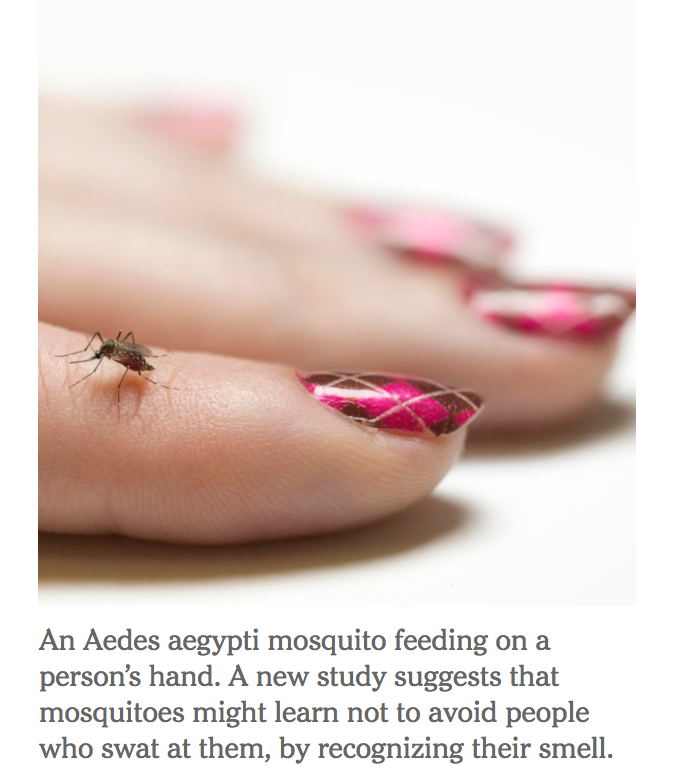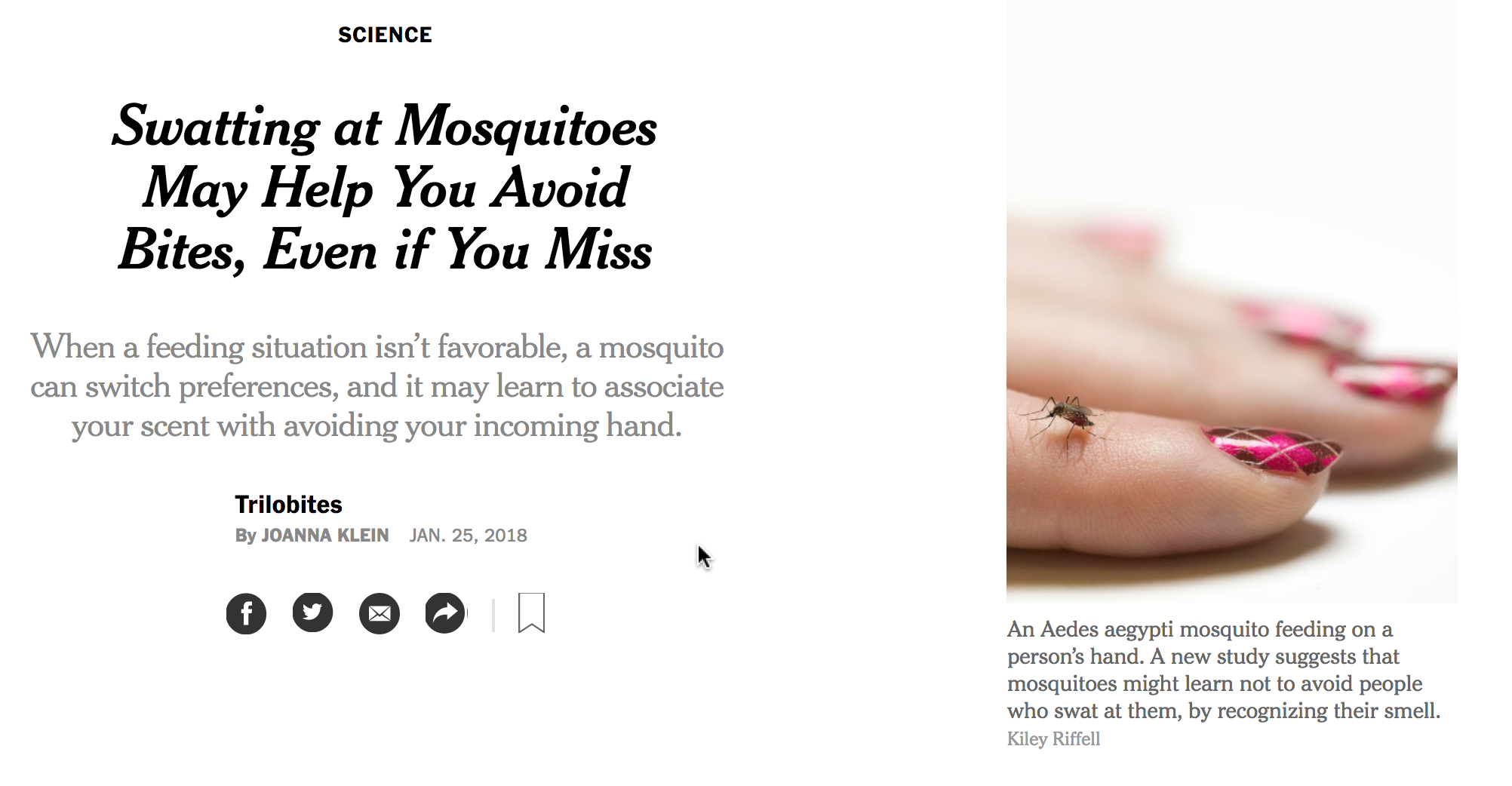Learning not to avoid
« previous post | next post »
 Joanna Klein, "Swatting at Mosquitoes May Help You Avoid Bites, Even if you Miss", NYT 1/25/2018:
Joanna Klein, "Swatting at Mosquitoes May Help You Avoid Bites, Even if you Miss", NYT 1/25/2018:
If you keep swatting at a mosquito, will it leave you alone?
Some scientists think so. But it depends.
Some blood meals are worth a mosquito risking its life. But if there’s a more attractive or accepting alternative to feed from, a mosquito may move on to that someone or something instead.
An interesting story. But this is Language Log, not Insect Learning Log, so let's focus on the prominently-displayed picture caption, which reads:
A new study suggests that mosquitoes might learn not to avoid people who swat at them, by recognizing their smell.
So I wondered, is "learn not to avoid" one of those phrases that is often used to mean the opposite of what the speaker or writer intended, like "fail to miss"?
Maybe this reversal sometimes happens, though it can be hard to tell:
[link] The data suggested 3 selection pressures were operative in improving the resemblances: (a) the combination of different components of the model's pattern (color) may increase protection against an individual predator, (b) an improved resemblance may protect the mimic from a greater variety of predators, and (c) an improved resemblance may decrease the chance that a predator will learn not to avoid the mimic.
But mostly things seem to come out right:
[link] The Girl Scout Leadership Experience helps girls learn not to avoid things that are hard for them, therefore helping them overcome fears, face challenges, and build resilience.
[link] With some dental cleaning videos starting to rise in popularity, we can only hope that people take the right lessons from watching them. They need to learn not to avoid dental visits.
[link] Yet we might learn not to avoid the dark,. not to race hurriedly from one patch of light to the next. For there is much the darkness can teach us.
Still, "might learn not to avoid people who swat at them" has several of the classic misnegation ingredients, including a modal, an explicit negation, and an implicit one.
Obligatory screenshot:
[h/t John Barenberg]

Dick Margulis said,
January 26, 2018 @ 8:36 am
"(c) an improved resemblance may decrease the chance that a predator will learn not to avoid the mimic."
This seems correct. It is in the predator's interest to learn that despite the mimicry, the prey is a tasty meal and therefore should not be avoided. The prey, on the other hand, wants the predator not to learn that lesson. Improved mimicry decreases the chance (good thing from the prey's point of view) that the predator will learn not to avoid it.
I don't think there's a reversal in that example.
[(myl) After a second cup of coffee, I think you're right…]
mistah charley, ph.d. said,
January 26, 2018 @ 9:31 am
1)Some languages – like this one – treat negations as logical operators – minus times minus equals plus.
Other languages – including colloquial versions of this one – treat serial negations as intensifiers – "not no way no how".
2)As I understand it, Buddhism teaches that the cause of a subjective feeling of unsatisfactoriness is craving – the desire for things to be different than they are – either with something better added – "this would be even better with white wine' – or with something unpleasant taken away. The latter is the urge to avoid – and so learning "not to avoid" is part of the art of mental cultivation.
Chas Belov said,
January 26, 2018 @ 11:57 am
@mistah charley, ph.d.
Interesting, my first reaction to "like this one" was to look for what language you were verbally pointing at, only to be immediately followed by a second reaction of "English, of course, the language of the comment" Alas, I don't drink coffee so can't go have my coffee.
Chas Belov said,
January 26, 2018 @ 12:01 pm
Actually, there is the matter of "this" as self-reference (as often used in programming languages and as used here in the comment) vs. "this" as pointer, for instance if the commenter had mentioned Chinese earlier in the comment.
DWalker07 said,
January 26, 2018 @ 2:32 pm
"…is "learn not to avoid" one of those phrases that is often used to mean the opposite of what the speaker or writer intended, like "fail to miss"?"
No, I never fail to miss the meaning of that phrase!
peter said,
January 26, 2018 @ 5:39 pm
@Chas Belov:
Your comments reminded me of the Scottish TV comedy program of 20-odd years ago entitled,
“No, This is This and Goodbye is Goodbye.”
Andrew Usher said,
January 26, 2018 @ 10:52 pm
Dick Margulis:
You're right, too, about the polarity, but I think you missed the scope issue: it should be 'not learn to avoid' rather than 'learn not to avoid'. Indeed the latter concept is strange, isn't it; 'not avoiding' something is not normally a decision one makes, not put that way.
k_over_hbarc@yahoo.com
Andrew Usher said,
January 26, 2018 @ 10:54 pm
Wow, did I actually type my e-mail address that way, or is it now automatically correcting me? No way to check (or edir)on this blog, so the only way is to try again (can't hurt):
k_over_hbarc at yahoo.com
Andrew Usher said,
January 26, 2018 @ 10:57 pm
(I insist that a working e-mail address be available – as it should for everyone. But I don't want to post it in a form a bot would read, especially if no one else does.)
By the way, the comma in the caption is also incorrect, in addition to the misnegation.
Ryan said,
January 27, 2018 @ 12:27 am
I think the misnegation is a little less excusable when "not to avoid" is put right next to the very prominent use of the words "help you avoid".
Biscia said,
January 27, 2018 @ 4:48 am
It looks to me like an editing error. Like a last-minute attempt to replace something longer (“not to go after”?) that would have made one word of the caption spill over onto the next line.
Andy said,
January 27, 2018 @ 8:55 am
The Times has removed the “not.”
Gregory Kusnick said,
January 27, 2018 @ 3:47 pm
Andrew Usher, I don't see a problem with "learn not to avoid", which seems to express the relevant concept concisely.
"Not learn to avoid" says something different, and incorrect in this case; it says that the predator fails to learn some lesson about avoidance. "Learn not to avoid" says that it succeeds in learning, and the lesson it learns is that the imperfect mimic is not a member of the category of noxious prey to be avoided.
As Dick says, successfully learning that lesson is what the mimic wants to decrease the chances of.
Andrew Usher said,
January 27, 2018 @ 6:23 pm
I'm not convinced, though I guess your preferred phrasing is an option, and makes more sense from the perspective of the paper's authors – though I certainly would have rephrased the sentence, it's tortured either way.
But in actual fact it's this: the mimic wishes the predator to 'learn to avoid' it. What it doesn't want is then the opposite, which is more usually expressed by 'not learn to avoid'. Animals don't think on the level 'OK, that creature is trying to mimic this thing I wish to avoid, but not well enough, so that I can tell and won't avoid it', which is I think what your human analysis is implying!
Gregory Kusnick said,
January 27, 2018 @ 7:01 pm
"the mimic wishes the predator to 'learn to avoid' it."
Not exactly. Avoidance is learned by eating the noxious model; the mimic has no control over that process. All it can control is whether the predator learns the additional skill of distinguishing mimic from model.
Haamu said,
January 28, 2018 @ 9:41 am
@Andrew Usher: Under what rule is the comma "incorrect"?
It does a decent job of directing us to the intended reading of "learn not to avoid [people who swat at them] by recognizing their smell" from the slightly garden-pathy "learn not to avoid people [who swat at them by recognizing their smell]." The comma lessens the reader's effort.
Avoid unnecessary commas, sure, but be careful about deeming something unnecessary. In other words, learn not to avoid commas that are helpful.
Graeme said,
February 2, 2018 @ 4:59 am
In writing many dozen newspaper op-eds to deadlines, I've found errors like these come through occasionally in late self-correction or sub-ed interference.
Eg the author may have originally had 'learn not to bite' or 'not to approach'. But on a final edit, 'bite' was seen as innacurate and 'approach' too vague. 'Avoid' came to mind as the mind rifled through 'A' words first. But the need to delete the negation was overlooked in the rush and sigh of hitting 'submit' in time.